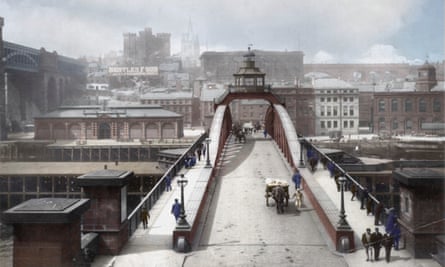On 17 July 1876, the world’s largest swinging bridge – a marvel of hydraulic engineering – opened for the first time, allowing access to the upper reaches of the River Tyne.
Since that day, the Newcastle Swing Bridge, designed by William Armstrong, one of the greatest names in British engineering, has opened on about 300,000 occasions for the passage of about half-a-million vessels.
But last weekend, as hundreds gathered to witness this industrial wonder in operation for the first time for more than 18 months, something deep within its bowels jammed fast.
The Port of Tyne authority, which is responsible for maintenance of the bridge, said the fault was “unforeseeable”. But the embarrassing malfunction has led to accusations the bridge is being allowed to fall into disrepair.
Historic England, the body responsible for the county’s historic environment, said the bridge is a “symbol of Tyneside’s industrial heritage and status”.
A spokesperson said: “The ability of the bridge to move as intended is a key part of its significance as a scheduled monument and Grade II*-listed building.”
Historic England said it was in contact with the port authority about the bridge but there had been “no discussions about the problems” with its ability to swing. “We would be willing to discuss any repair issues to make it operate successfully.”

Chi Onwurah, the Labour MP for Newcastle Central, said the bridge was an “iconic example of Geordie history and ingenuity”. She acknowledged there were “huge challenges” in maintaining it, but stressed it was “crucial to preserve this important example of engineering”. The port authority was “accountable to the region and the nation for the maintenance of this historic bridge,” she told the local news website Chronicle Live.
Greg Stone, a Liberal Democrat councillor in the area, said the cost of upgrading Victorian-era engineering was at the root of the problem.
“There is not a lot of spare cash at the moment, but this is a monument to Tyneside’s industrial heritage. Whether it can be kept in working order now seems to be in question.”
The port authority said it had invested £1m in the past 15 years in the bridge’s upkeep. A team of engineers had made checks ahead of last weekend’s scheduled opening, but an internal pressure valve deep failed, preventing the bridge from opening.
A Port of Tyne spokesperson said: “It was unforeseeable and, given the age of the component and where it is situated, impossible to repair at the time. We fully understand how important the swing bridge is as part of the city’s heritage, and we have our engineers working on it to fix the problem, and ensure the bridge can continue to swing.”
The Europa, the first ship to pass through the 171 metre-wide bridge, sailed upriver to the Elswick Ordnance Works, founded by Armstrong three decades earlier, where it took possession of a huge gun on behalf of the Italian government.
Armstrong, an inventor and philanthropist as well as a pioneering engineer, had become one of the wealthiest men in Europe by the time he died aged 90 in 1900. His obituary in the Times said: “With his death, Newcastle loses her greatest citizen, and the country at large one of the worthies of the expiring century.”
